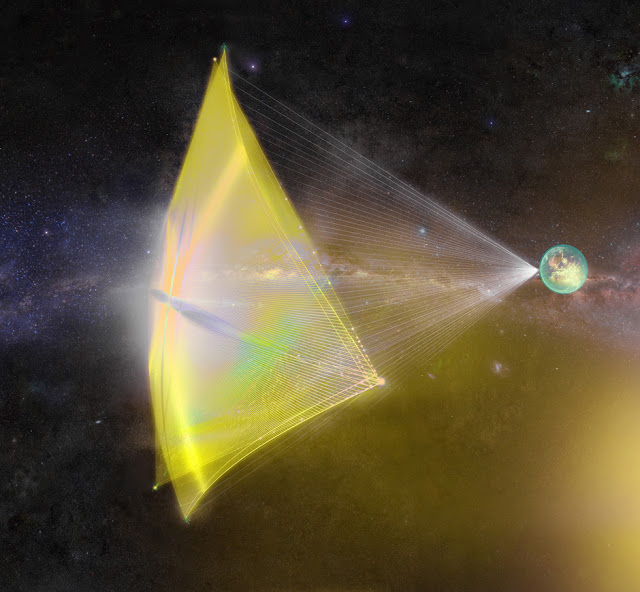A few days ago Centauri Dreams Paul Glister was at the Breakthrough Starshot meetings
Starshot engineering activities are targeting a 20% of lightspeed mission to Alpha Centauri. Kevin Parkin leads the subcommittee has oversight over a systems team that will conduct system engineering, modeling and integration activities.
The team is comfortable with the design choice of a laser pushed sail.
Aboard the sail would be a small payload, perhaps the size of a smartphone, perhaps even smaller, that is built around what the project is calling a StarChip. We’re talking a payload that is measured in grams rather than kilograms, using breakthroughs in miniaturization to fold in communications, navigation, cameras, power supply and LED-like ‘thrusters.’
The early discussions have included a sail of about four meters to the side, itself weighing no more than grams. The sail has advantages that place it far above any other propulsion methods available today. Chemical rockets require far too much propellant to even consider a star mission. Fusion is not available. A sail can be placed under a beam of directed energy that drives it, planners hope, to twenty percent of the speed of light. In the initial Starshot concept, that beam of energy comes from a colossal phased array of lasers, to be built in southern latitudes. The Atacama desert of Chile is often mentioned.
Swarm technologies that would leverage the fact that Starshot is not one sail but hundreds, perhaps thousands. Multiplying the number of sails offers the kind of redundancy that allows for projected losses through collisions with dust in the interstellar medium.
The consensus seems to be that sails and payloads can survive the journey, with some losses along the way.
The systems subcommittee reported on applying the $100 million funding for technology analysis and development over a span of five years. This will be followed by a prototype that would take the cost up to $1 billion.
The lowest estimate seen for an actual mission with these technologies is $10 billion.
Lubin’s designs would enable wafersats to reach 25% of lightspeed and a 100 ton spaceship to reach 1000 kilometers per second.

Brian Wang is a Futurist Thought Leader and a popular Science blogger with 1 million readers per month. His blog Nextbigfuture.com is ranked #1 Science News Blog. It covers many disruptive technology and trends including Space, Robotics, Artificial Intelligence, Medicine, Anti-aging Biotechnology, and Nanotechnology.
Known for identifying cutting edge technologies, he is currently a Co-Founder of a startup and fundraiser for high potential early-stage companies. He is the Head of Research for Allocations for deep technology investments and an Angel Investor at Space Angels.
A frequent speaker at corporations, he has been a TEDx speaker, a Singularity University speaker and guest at numerous interviews for radio and podcasts. He is open to public speaking and advising engagements.



